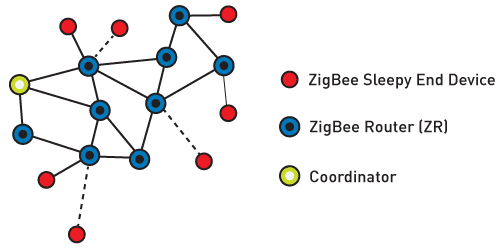Last update: 2016 Apr 11
As wikipedia states nicely, “ZigBee is an IEEE 802.15.4-based specification for a suite of high-level communication protocols used to create personal area networks with small, low-power digital radios.”
It’s a rather simple way to transfer data from a bunch of wireless sensors distributed in your house. Another very important characteristic is its true mesh routing, allowing a more resilient architecture.
The one thing you need to understand how a zigbee network works is it relies on a PAN ID which is unique for a given group of nodes, and a node can play 3 roles:
- a coordinator (ZC): there is only one coordinator in one given PAN. Its role is to create the network and helps on its routing
- a router (ZR): you can have any number of routers in A PAN. They both emit new data and help to route data from other nodes
- an end device (ZED): you can any number of EDs in a PAN and work similarly to a router except they don’t route data from other nodes
Here is an example:
